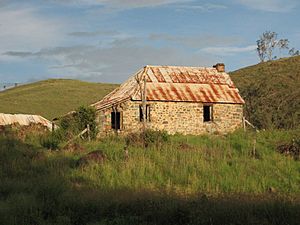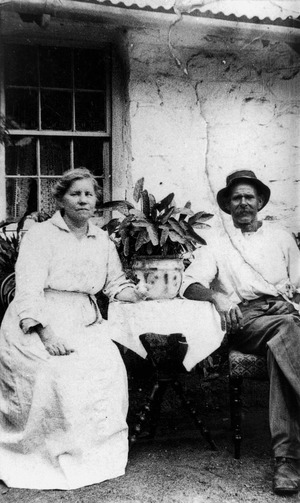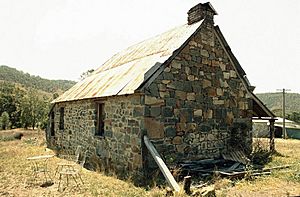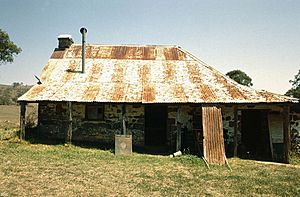Stonehouse, Moore facts for kids
Quick facts for kids Stonehouse, Moore |
|
|---|---|

Stonehouse, 1979
|
|
| Location | D'Aguilar Highway, Moore, Somerset Region, Queensland, Australia |
| Design period | 1870s - 1890s (late 19th century) |
| Built | c. 1874 - 1888 |
| Official name: Stonehouse, Moore Stone Houses | |
| Type | state heritage (built, archaeological) |
| Designated | 25 October 2002 |
| Reference no. | 601626 |
| Significant period | 1870s-1880s (fabric) 1870s-1910 (historical) |
| Significant components | store/s / storeroom / storehouse, kitchen/kitchen house, hotel / inn |
| Lua error in Module:Location_map at line 420: attempt to index field 'wikibase' (a nil value). | |
Stonehouse is a special group of old stone buildings located on the D'Aguilar Highway in Moore, Australia. It used to be a family home and a place where travelers could stop, like an old hotel. The buildings were constructed between about 1874 and 1888. Today, Stonehouse is listed on the Queensland Heritage Register, which means it's an important historical site that needs to be protected.
Contents
History of Stonehouse
Stonehouse was built in the 1870s and 1880s. It was part of a home and an inn (a place for travelers to stay) along an old road. This road was used by horse-drawn coaches traveling between Esk and Nanango.
Early Land and Settlement
The land where Stonehouse stands was once part of a large farming area called "Colinton." This area was first used for grazing animals in 1841. In the 1840s, more people started settling in the Moreton Bay and Brisbane Valley areas of Queensland. This happened after a prison colony in Moreton Bay (now Brisbane) closed down. Explorers had found the land good for farming, and by 1842, many large farms were set up.
The Williams Family Arrives
Queensland became its own state in 1859. Later, in 1868, a new law made smaller pieces of land available for more settlers. This brought many new families to the Brisbane Valley. In 1873 and 1874, about 30 members of the Williams family arrived in Queensland from England.
Robert Williams, who had lived in Ipswich before, chose two pieces of land from the Colinton area in 1874. He wanted to use it for grazing. He named his new property "Stonehouse" after his old village in England. His brother Charles, who was a stonemason (a person who builds with stone), started building a five-room stone house there. Building with stone was unusual then, but it made sense for a family of stonemasons. They used stone found right on the property.
Stonehouse as a Wayside Inn
In the 1870s, a man named Edward MacDonald started a coach and mail service. It ran between his hotel in Esk and another inn in Nanango. Stonehouse became one of the stops where horses could be changed. The Williams family built stables across the road for the horses.
In 1880, Robert Williams got a license to open a hotel called the Stonehouse Hotel. Places like this, where major roads crossed rivers, were perfect for inns. Travelers could get food, a place to sleep, and fresh horses. They could also send or pick up mail and find out about the road ahead. These inns were very important for helping new areas develop.
In 1884, Robert Williams lost his hotel license after an argument happened near the hotel. However, he still offered food and a place to stay for travelers. Stonehouse was even mentioned in a popular old song called Brisbane Ladies as a stopping point on the road.
Changes and Later Years
In 1882, Emma Williams died and was buried near a creek. Her grave was later washed away by a flood in the 1940s. Robert Williams remarried. His nephew, Frank Williams, who was learning to be a stonemason, built a kitchen and pantry. Charles Williams died in 1887. The last stone building work at Stonehouse was done in 1888 by Frank, who finished the store and butcher's shop.
In 1893, Alex MacCallum took over the mail service that used Stonehouse. This service ran until 1910. Around 1900, people started thinking about building a railway in the area. Stonehouse, being a coach stop, was part of the discussions. As more settlers moved in, Stonehouse also became a store and butcher's shop for them.
A small town called Moore grew nearby, and a railway station opened there in 1910. This meant fewer coaches and travelers stopped at Stonehouse.
Robert Williams died in 1907. His nephew, Thomas Williams, took over Stonehouse in 1908. By 1910, repairs were needed, and the original roof shingles were covered with iron. Between 1914 and 1918, the first house was taken down, and the stables collapsed.
In 1923, the Williams family moved to Brisbane and leased Stonehouse to others. The land was later divided and sold. Over the years, more buildings at Stonehouse were taken down, including a buggy shed and workshop. In 1967, a storm damaged the main building, and part of it had to be removed. Some of its stone blocks were even used to build a picnic shelter in Moore.
In 2001, new owners bought the property and promised to help preserve Stonehouse.
What Stonehouse Looks Like Today
Today, Stonehouse has three main stone buildings on the south side of the highway. They are on a small hill that goes down to a creek. People think the stone used to build them came from the hill behind the buildings.
The Main Building Ruins
Closest to the highway are the remains of the main building. It's mostly ruins now, with some stone walls still standing. You can see the old wooden frames for windows and doors, but the windows and doors themselves are gone. Parts of the roof frame are also left. Much of the stone from this building has been removed over time.
The Kitchen and Pantry
Behind the main building is a separate kitchen and pantry. This building is still complete. It's a rectangular stone building with a roof that extends over an earth floor on one side, like a porch. The roof is made of corrugated iron over wooden poles. Inside, the walls are whitewashed, and there's a wooden floor. One end has a large fireplace and a cooking area with a brick floor. At the other end is a smaller room with a brick floor, which was probably the pantry.
The Store and Butcher's Shop
Further back from the kitchen is the store and butcher's shop. It's also made of stone and has a gabled roof with corrugated iron. It has three rooms: a large room with a wooden floor and two smaller rooms at the end. The back room has stone paving under a concrete layer. Part of the wall at this end is covered with corrugated iron, and another section has old wooden slabs.
A modern metal shed is now located behind the store, where a blacksmith's shop and chicken coops used to be. There are no longer any signs of the other old buildings that were once at the back of the property.
A timber house from the mid-1900s is at the front of the property and is where people live now.
Why Stonehouse is Important
Stonehouse was added to the Queensland Heritage Register on October 25, 2002. This means it's recognized as a very important historical site for several reasons:
- It shows how Queensland grew: Stonehouse helps us understand how European settlers moved into Queensland. Inns like this were vital for early travel and trade, helping new areas develop. It shows how the area changed from large farms in the 1840s to smaller settlements from the 1870s.
- It's a rare example: Stonehouse is special because it's one of the few old travelers' inns still standing in Queensland. It's also rare to find a group of early stone buildings that used materials found right on the site.
- It can teach us more: The buildings and the land around Stonehouse can help us learn more about how wayside inns worked in Queensland's past.
- It's a great example of its type: Stonehouse is a good example of an early inn complex. It shows old building methods using both stone and timber.
- It looks beautiful: The Stonehouse buildings are well-made and have a pleasing look. Because they used local stone, they fit in well with the surrounding landscape. Their location on the highway has made them a well-known landmark.
- It's connected to important people: Stonehouse is strongly linked to the Williams family, who came from England in the 1870s. Charles and Frank Williams, who built parts of Stonehouse, were important stonemasons. Frank Williams later became famous for building many war memorials, like the ones in Esk and Warwick.




